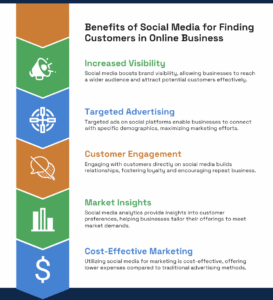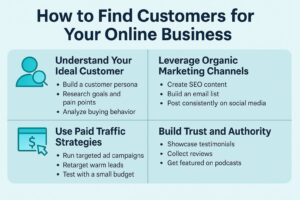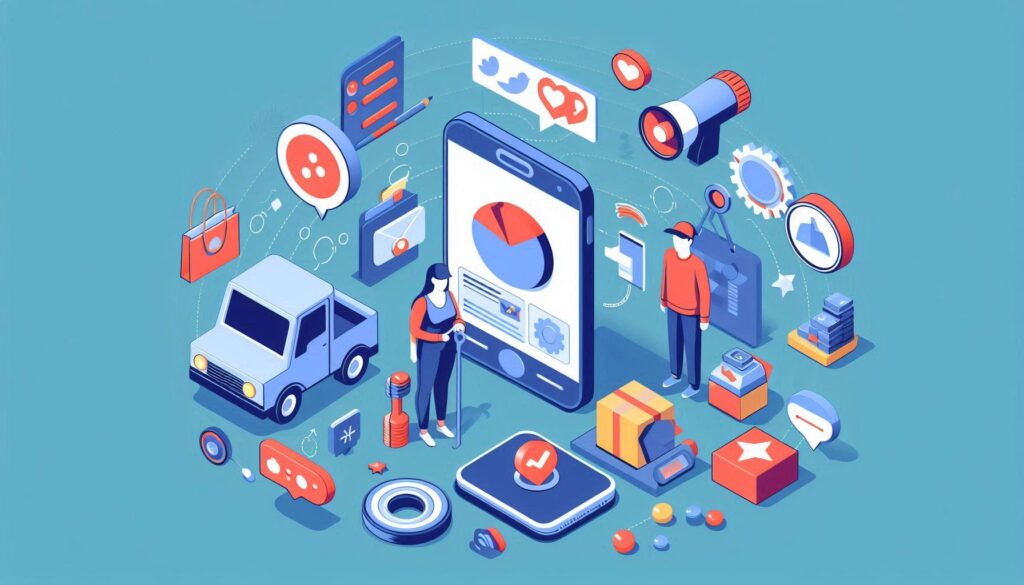Launching an online business is exciting—but once the site goes live and the branding is polished, most entrepreneurs hit the same wall: how do I actually find customers?
You’re not alone. In a digital landscape full of noise, it’s no longer enough to simply build it and hope they come. You need a strategic, multi-channel approach to attracting, converting, and retaining customers who actually want what you’re selling.
Whether you run an eCommerce store, offer services, or sell digital products, this guide walks you through how to find your ideal customers in 2025—without wasting time or money.
Let’s dive in.
Organic traffic is an immensely powerful tool—effortlessly drawing warm traffic that converts. We have experience attracting that traffic with high-quality, cost-effective written content. Click below to work with us.
1. Understand Your Ideal Customer First
Before you market to anyone, you need to know who you’re talking to.
Too many businesses try to attract “everyone” and end up resonating with no one. Instead, build a clear customer profile that includes:
- Demographics (age, location, income, occupation)
- Psychographics (goals, values, challenges, objections)
- Buying behavior (how they research and decide)
How to do this:
- Interview past or potential customers
- Use tools like Google Trends, Reddit, or AnswerThePublic
- Spy on competitors’ reviews and communities
- Run simple surveys or polls
Once you know their pain points and what matters to them, your messaging will be magnetic—and your marketing will convert.
2. Optimize Your Website to Convert Visitors
Your website is your online storefront. If it’s confusing, slow, or generic, visitors will bounce.
Here’s how to turn traffic into leads and customers:
📘 Have a Clear Value Proposition
In the first 3 seconds, visitors should understand:
- What you offer
- Who it’s for
- Why it matters
📘 Make Your CTA Obvious
Whether it’s booking a call, buying a product, or downloading a lead magnet—make it clear, compelling, and above the fold.
📘 Build Trust Fast
Include:
- Testimonials and reviews
- Trust badges or guarantees
- Real client logos or case studies
📘 Prioritize Mobile Experience
Over 60% of traffic happens on mobile. Your site must load quickly and work seamlessly on all devices.
Pro tip: Use tools like Hotjar to see where users drop off—and fix it.
3. Leverage Organic Marketing Channels
Organic marketing builds long-term visibility and trust without paying for every click. It’s slower than ads but often far more sustainable.
a. Content Marketing
Publishing value-packed blog posts helps:
- Improve SEO (Google visibility)
- Build authority in your niche
- Attract customers who are actively searching for answer
The Phantom Ink provides professional written content at scale.
b. Search Engine Optimization (SEO)
Invest in keyword research and basic on-page SEO:
- Optimize titles, headers, and meta descriptions
- Add internal links and alt text to images
- Target long-tail keywords (e.g., “best time management app for freelancers”)
SEO is a compounding asset—content you publish today can generate leads for years.
c. Email Marketing
Even in 2025, email isn’t dead—it’s direct, personal, and high-converting.
Steps:
- Offer a lead magnet (e.g., checklist, ebook, free tool)
- Build an email list
- Send helpful, regular content that builds trust
- Promote your offer naturally
Check out our article on the importance of written content for online businesses in 2025.
4. Use Paid Traffic to Accelerate Results
Want faster traction? Paid ads can help you get in front of your audience instantly—but only if you’re strategic.
Where to Start:
- Google Ads – Great for buyers with intent
- Facebook/Instagram Ads – Ideal for targeting interests/demographics
- YouTube Ads – Excellent for education and brand trust
Use paid ads to:
- Drive traffic to high-converting landing pages
- Promote free offers to build your list
- Retarget warm leads who visited but didn’t buy
Pro Tip: Start with a small test budget and monitor conversions, not just clicks.
5. Build an Audience on Social Media

Social media isn’t just for dancing trends or memes—it’s a powerful way to build trust and attract inbound leads.
Choose the right platform:
- Instagram – Visual brands, influencers, creators
- LinkedIn – B2B, service providers, consultants
- TikTok – Gen Z, creators, informal and fun
- Pinterest – DIY, eCommerce, bloggers, creators
Don’t spread yourself too thin. Focus on 1–2 platforms and show up consistently.
What to Post:
- Tips or insights from your blog posts
- Customer stories or transformations
- Behind-the-scenes content
- Mini case studies or carousel posts
- Calls to action to join your list or DM you
Engagement leads to conversation. Conversations lead to clients.
6. Create Partnerships and Referral Engines
You don’t need to do this alone. Collaborating with others can be a game-changer.
Ideas:
- Partner with complementary businesses (e.g., a brand designer + copywriter)
- Run guest workshops in others’ communities
- Offer referral or affiliate commissions to happy clients
- Join mastermind groups, Slack communities, or Facebook groups where your customers hang out
Sometimes one good referral is better than a hundred cold emails.
7. Use Authority & Trust Signals to Stand Out
People buy from those they trust. Build that trust by showing real proof.
Quick Wins:
- Ask happy clients for reviews or testimonials (video = gold!)
- Turn success stories into case studies or blog posts
- Display social proof like “3,000+ business owners served”
- Get featured on podcasts, webinars, or industry blogs
Authority builds confidence—and confidence drives conversions.
8. Nurture Leads Until They’re Ready to Buy
Most people don’t buy right away. That’s normal.
The key is to stay top-of-mind without being pushy.
Nurture tactics:
- Weekly emails with tips and case studies
- Retargeting ads on social and Google
- Free trainings, challenges, or value-packed downloads
- Strategic follow-ups via DM or email
Keep showing up with value, and when they’re ready—they’ll come to you.
9. Track, Tweak, and Test What Works
Growth is a process. You need to monitor what’s working—and double down on it.
Use tools like:
- Google Analytics 4 – traffic and conversions
- Hotjar or Clarity – user behavior
- UTM parameters – track ad performance
- Email platform analytics – open and click rates
Test different offers, messaging, and formats. Small tweaks can lead to big wins.
10. Action Plan: Start Small, Scale Up
Here’s how to put this into action today:
Week 1:
- Define your ideal customer
- Audit your website for clarity and conversion
Week 2:
- Write one blog post targeting a keyword your audience is searching
- Set up a simple lead magnet + email welcome sequence
Week 3:
- Post content 3x per week on your best platform
- Start engaging in relevant online communities
Week 4:
- Test a small $50–$100 paid ad campaign
- Reach out to 3 potential partners for a collab or guest feature
Week 5:
- Evaluate results and expand on what’s working
- Start scaling and repurposing content creation
Conclusion: Attracting Customers Is a Skill—Not Luck

Finding customers for your online business doesn’t require viral hacks or sleepless hustle. It requires:
- Clarity on who you serve
- A message that resonates
- Consistent visibility in the right places
Master that, and you’ll build a predictable, profitable business—without chasing every new tactic.
If you need help creating content that wins, take a look at our offerings—we know what works.
FAQ
Q: What’s the fastest way to get my first customer?
A: Start with your existing network. Ask for referrals. Offer a beta test or limited-time offer. Then build your visibility via social or email.
Q: Do I need to be on every platform?
A: No! It’s better to go deep on one platform where your audience hangs out than to be shallow on five.
Q: Should I hire someone to do this for me?
A: Hiring a copywriter can save you time—and help you attract better-fit clients faster, while allowing you to easily scale with your budget. At The Phantom Ink, we write content that converts, driving traffic, conversions, and increasing authority in your industry.




